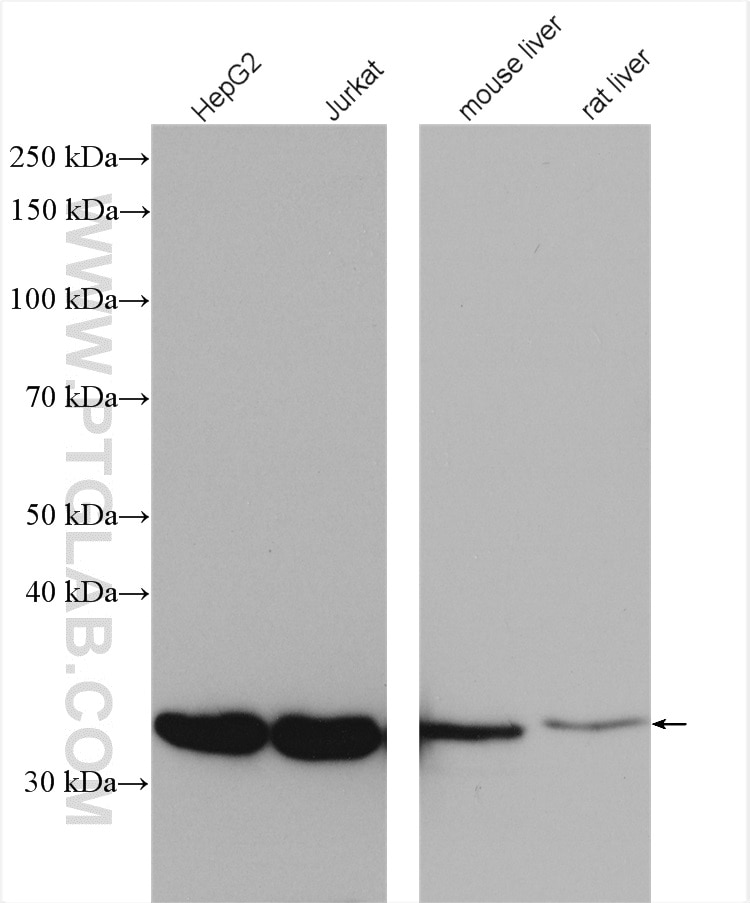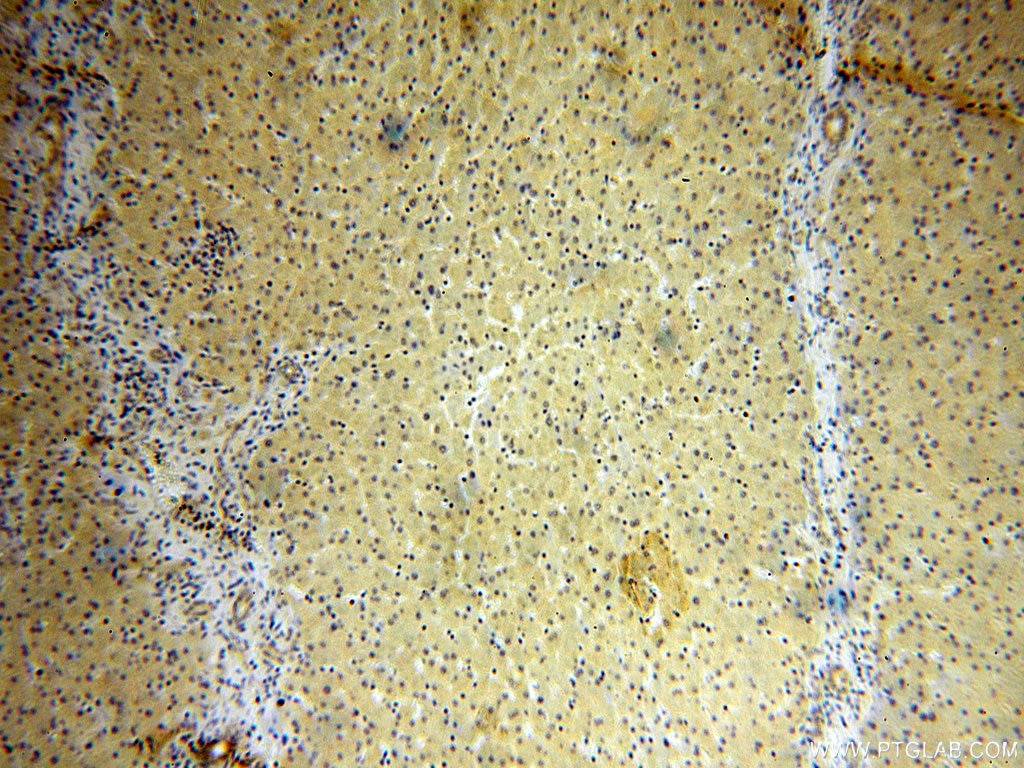- Phare
- Validé par KD/KO
Anticorps Polyclonal de lapin anti-CPOX
CPOX Polyclonal Antibody for WB, IP, IHC, ELISA
Hôte / Isotype
Lapin / IgG
Réactivité testée
Humain, rat, souris
Applications
WB, IP, IF, IHC, ELISA
Conjugaison
Non conjugué
N° de cat : 12211-1-AP
Synonymes
Galerie de données de validation
Applications testées
| Résultats positifs en WB | cellules HepG2, cellules Jurkat, cellules K-562, tissu hépatique de rat, tissu hépatique de souris |
| Résultats positifs en IP | cellules HepG2 |
| Résultats positifs en IHC | tissu de cancer du foie humain, tissu hépatique humain il est suggéré de démasquer l'antigène avec un tampon de TE buffer pH 9.0; (*) À défaut, 'le démasquage de l'antigène peut être 'effectué avec un tampon citrate pH 6,0. |
Dilution recommandée
| Application | Dilution |
|---|---|
| Western Blot (WB) | WB : 1:1000-1:4000 |
| Immunoprécipitation (IP) | IP : 0.5-4.0 ug for 1.0-3.0 mg of total protein lysate |
| Immunohistochimie (IHC) | IHC : 1:50-1:500 |
| It is recommended that this reagent should be titrated in each testing system to obtain optimal results. | |
| Sample-dependent, check data in validation data gallery | |
Applications publiées
| KD/KO | See 1 publications below |
| WB | See 3 publications below |
| IHC | See 4 publications below |
| IF | See 1 publications below |
Informations sur le produit
12211-1-AP cible CPOX dans les applications de WB, IP, IF, IHC, ELISA et montre une réactivité avec des échantillons Humain, rat, souris
| Réactivité | Humain, rat, souris |
| Réactivité citée | Humain, souris |
| Hôte / Isotype | Lapin / IgG |
| Clonalité | Polyclonal |
| Type | Anticorps |
| Immunogène | CPOX Protéine recombinante Ag2858 |
| Nom complet | coproporphyrinogen oxidase |
| Masse moléculaire calculée | 454 aa, 50 kDa |
| Poids moléculaire observé | 36 kDa |
| Numéro d’acquisition GenBank | BC023551 |
| Symbole du gène | CPOX |
| Identification du gène (NCBI) | 1371 |
| Conjugaison | Non conjugué |
| Forme | Liquide |
| Méthode de purification | Purification par affinité contre l'antigène |
| Tampon de stockage | PBS avec azoture de sodium à 0,02 % et glycérol à 50 % pH 7,3 |
| Conditions de stockage | Stocker à -20°C. Stable pendant un an après l'expédition. L'aliquotage n'est pas nécessaire pour le stockage à -20oC Les 20ul contiennent 0,1% de BSA. |
Informations générales
CPOX(Coproporphyrinogen-III oxidase, mitochondrial) is also named as CPO and CPX. Human CPO is a 76 kDa protein that is active as a homodimer in the mitochondrial intermembrane pace(PMID:16159891).Mutations in human CPO gene predict the clinical outcome of the disease, with either hepatic hereditary coproporphyria or hematological manifestations of erythropoietic harderoporphyria.CPOX has a transit peptide of 110 aa and the chain contains 344 aa.
Protocole
| Product Specific Protocols | |
|---|---|
| WB protocol for CPOX antibody 12211-1-AP | Download protocol |
| IHC protocol for CPOX antibody 12211-1-AP | Download protocol |
| IP protocol for CPOX antibody 12211-1-AP | Download protocol |
| Standard Protocols | |
|---|---|
| Click here to view our Standard Protocols |
Publications
| Species | Application | Title |
|---|---|---|
J Cell Biol Parkin-independent mitophagy via Drp1-mediated outer membrane severing and inner membrane ubiquitination. | ||
Neuro Oncol Enhanced expression of coproporphyrinogen oxidase in malignant brain tumors: CPOX expression and 5-ALA-induced fluorescence. | ||
Biochem Pharmacol Cystathionine-γ-lyase (CSE) deficiency increases erythropoiesis and promotes mitochondrial electron transport via the upregulation of coproporphyrinogen III oxidase and consequent stimulation of heme biosynthesis.
| ||
Front Med (Lausanne) Heme Biosynthesis Factors and 5-ALA Induced Fluorescence: Analysis of mRNA and Protein Expression in Fluorescing and Non-fluorescing Gliomas. | ||
Photodiagnosis Photodyn Ther Expression of coproporphyrinogen oxidase is associated with detection of upper gastrointestinal carcinomas by 5-aminolevulinic acid-mediated photodynamic diagnosis. | ||
Photodiagnosis Photodyn Ther Protoporphyrinogen oxidase is involved in the fluorescence intensity of 5-aminolevulinic acid-mediated laser-based photodynamic endoscopic diagnosis for early gastric cancer. |










